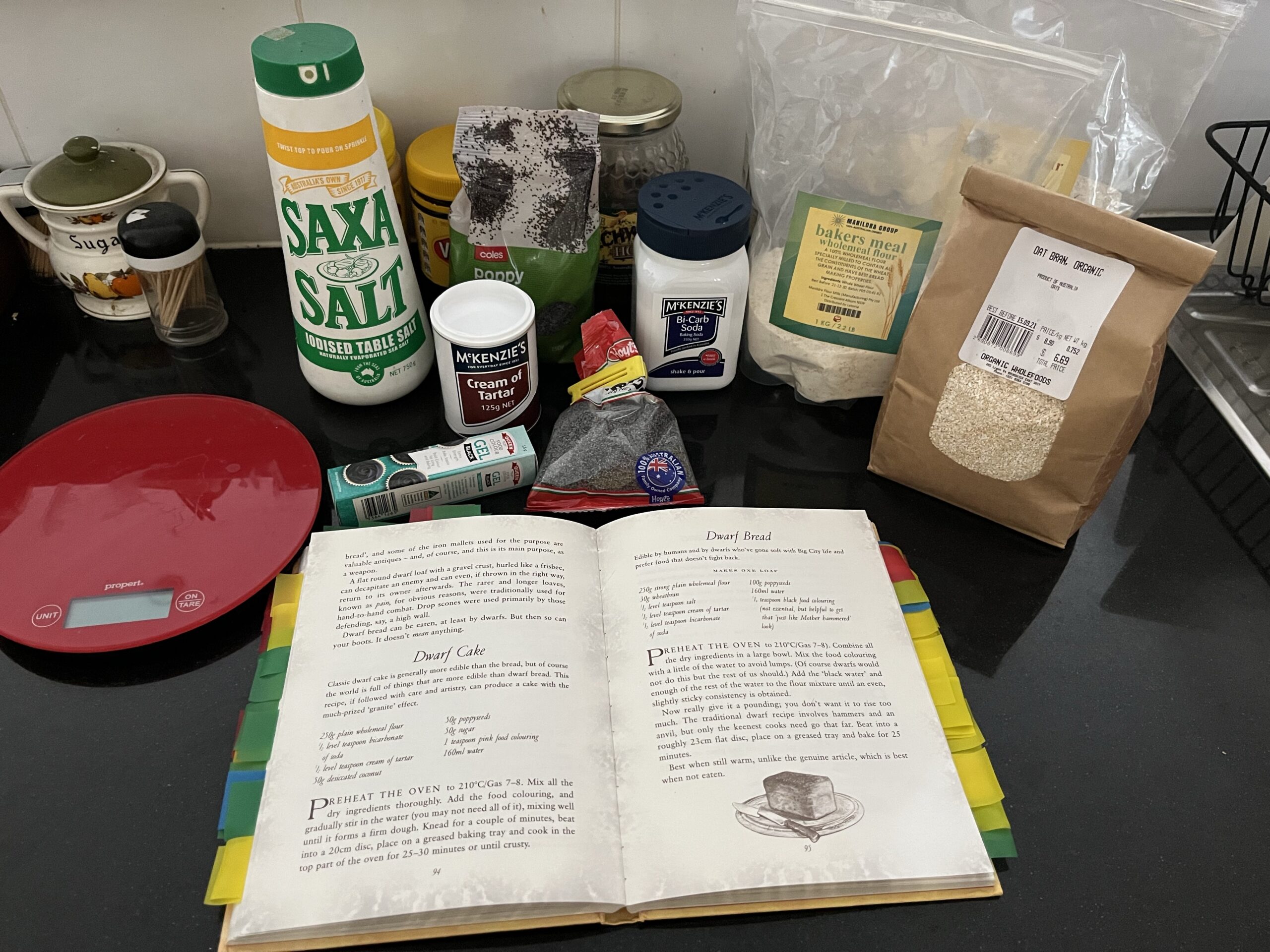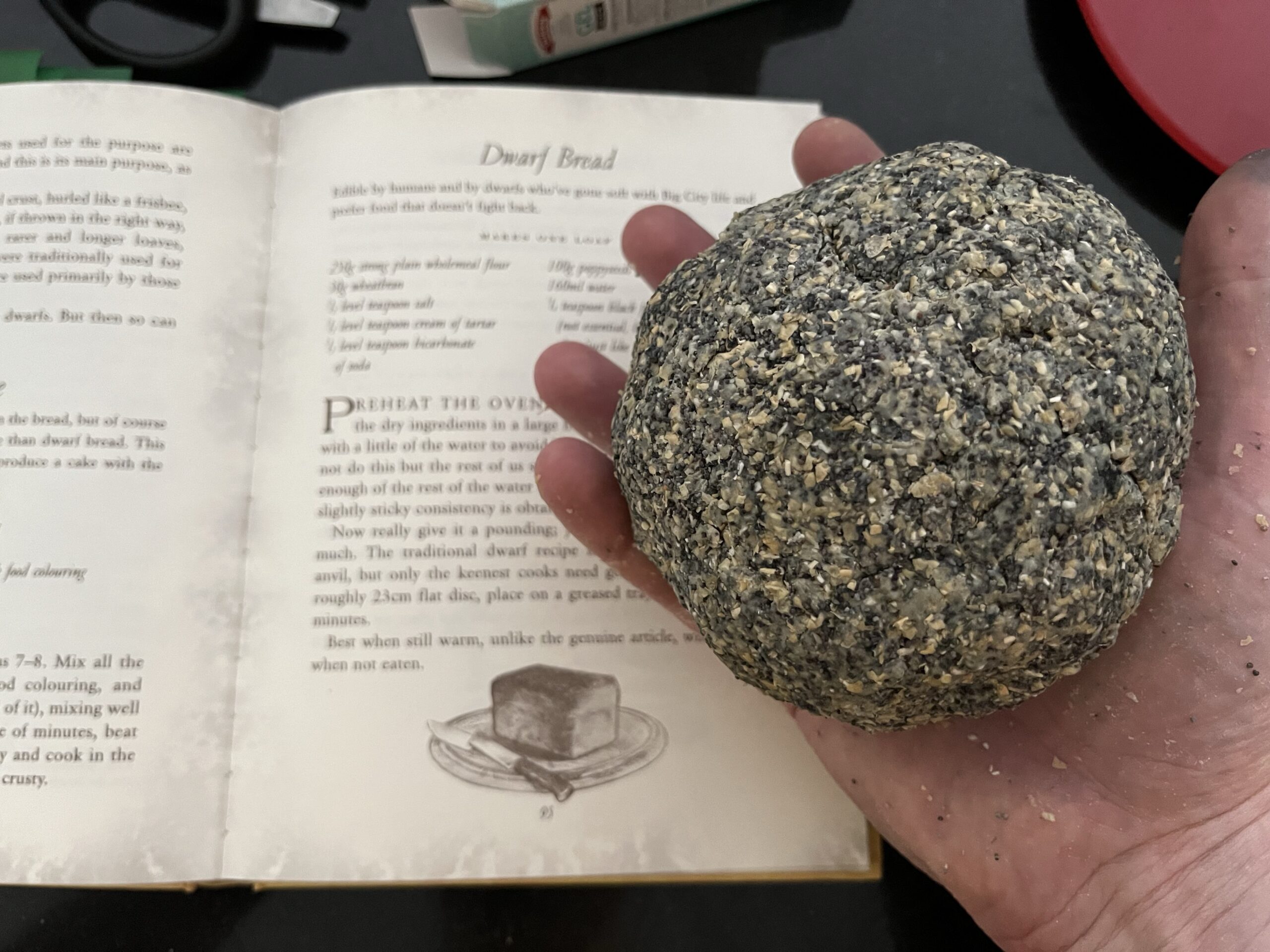#Pratchat63 Notes and Errata
These are the episode notes and errata for Pratchat episode 63, “Decline by Committee“, discussing the 2005 Discworld short story “A Collegiate Casting-out of Devilish Devices”, plus some extra discussion of the novel Thud!, with special guest Matt Roden.
Iconographic Evidence
Here’s the “Explaining a Board Game” sketch from Australian sketch group Aunty Donna, which Ben has indeed been sent many, many times – including by Matt, shortly after we recorded this episode.
Notes and Errata
- The episode title is a pun on the phrase “Design by Committee”, which refers to a situation where no-one is in charge of the design of a product, leading to a lack of direction.
- “Trilogy in four parts” is borrowed from Douglas Adams, who described The Hitchhikers Guide to the Galaxy book series this way after publishing the fourth novel, So Long and Thanks For All the Fish. It later became “The Increasingly Innacurately Named Hitchhikers Trilogy” with the publication of the fifth book Mostly Harmless.
- You can find the first three parts of our trilogy here:
- #PratchatPlaysThud – “The Troll’s Gambit”, about Thud the board game, with Dr Melissa Rogerson
- #Pratchat61 – “What Terry Wrote”, about Thud!, with Matt Roden.
- #Pratchat62 – “There’s a Cow in There“, about Where’s My Cow?, with Jo and Francine from The Truth Shall Make Ye Fret.
- “Nepo baby” was a buzz-term in late 2022. It’s short for “nepotism baby”, a new name for the concept of getting a leg up via a family connection. That’s as old as…well, a very old thing, but discussion of it really took off as younger social media users learned to their surprise that many Hollywood stars and influencers have parents or other relatives they’d never heard of who are also in show business. Matt asks Ben if he read “the article” – Ben hadn’t, but we think Matt meant “What is a Nepotism Baby, Anyway? How a ‘Nepo Baby’ is Born” by Nate Jones for Vulture, which was also a cover story for New York magazine.
- Ridcully’s snooker table covered in paperwork appears not in Lords and Ladies, but in Soul Music. A footnote reveals that a wizard’s trick shots can include temporal spin, and that Ridcully once bounced a ball off the Bursar’s head “last Tuesday”.
- We’ve listed below the senior faculty members of Unseen University who appear in most of the Wizards books. (We’ve tried to avoid any spoilers here for books not yet covered on the podcast.)
- Mustrum Ridcully, Archchancellor
- Ponder Stibbons, Head of Inadvisably Applied Magic, Reader in Invisible Writings, and Praelector. (He later acquired more titles, including Reader in Non-Volatile Intelligence, Cantoride Speaker in Slood Refurgance and at least one it would be a spoiler to reveal here.)
- A. A. Dinwiddie (aka “The Bursar”), Bursar. His name is revealed in The Truth.
- Henry (last name not revealed), the Dean of Pentacles, known as “the Dean”. (His name is revealed in a later book.)
- The Lecturer in Recent Runes.
- The Chair of Indefinite Studies.
- The Senior Wrangler.
- Ponder Stibbons and Victor Tugelbend were students taking final exams at the time of the rediscovery of Holy Wood, as chronicled in Moving Pictures. (See #Pratchat10, “We’re Gonna Need a Bigger Broomstick”.) This was indeed also the first appearance of Archchancellor Ridcully, though he doesn’t play a major part in a novel until Reaper Man, which also introduces the rest of the faculty we know best.
- We discussed our theories about Rincewind’s entry into Unseen University in #Pratchat55, “Mr Doodle, the Man on the Moon”.
- The “National Interest Test” (NIT) was a requirement added to the grant application process for the Australian Research Council (ARC) in 2018 by the previous Liberal/National coalition government. The ARC is the independent body which assesses university grant applications for research, and recommends which projects should get grants to the Minister, who generally approves all of them. But the NIT was part of an increasingly commercial agenda of the conservative government to restrict research, and in 2021 further recommendations were given to the ARC to make this more stringent. In late December 2021, Acting Education Minister Stuart Robert rejected six grants which had been approved and recommended by the ARC on the grounds that they were not “good value for taxpayers’ money” or in the national interest. The timing of the announcement – just before Christmas – and the nature of the projects removed (which included subjects like climate change and political activism in China) suggested a political motive for the rejections, which was met with .
- The wizard who knows about stories is most likely Ladislav Pelc, Prehumous Professor of Morbid Bibliomancy, whom Moist goes consults about the Post Office’s letters in Going Postal. He has very large ears and no beard, but out of deference to wizarding tradition he wears a false one when in view of the public.
- The incident with Windle Poons is in Reaper Man; the other wizards attempt to bury him at the corner of the Street of Small Gods and Broad Way, described as two of the busiest streets in Ankh-Morpork.
- There are many schools in Ankh-Morpork, aside from Unseen University itself:
- The Assassin’s Guild school appears most prominently in Pyramids and Night Watch.
- The Clockmaker’s Guild – which seems to provide more of an apprenticeship – appears in Thief of Time. It’s implied the Thieves’ Guild has a school or apprenticeship program as well.
- The Fool’s Guild school is important in Wyrd Sisters and Men at Arms.
- The Musician’s Guild may also offer more of an apprenticeship, but they raised and taught Keith, Maurice’s “dumb kid”, as he mentions in The Amazing Maurice and His Educated Rodents.
- By the time of Thief of Time, Susan (who herself went to Quirm College for Young Ladies) is teaching at Madam Frout’s Learning Through Play School.
- We previously brought up the issue of copaganda – the bias towards showing police in a positive light in news media and popular culture – in #Pratchat52, “A Near-Watch Experience”, though we never quite got around to discussing it. Ben’s not sure we’ve done the discussion justice here, either – he’s had more thoughts since the episode – but the concept pre-dates the word, going back to at least the 1950s and the publicity stunt puff pieces in newspapers about police officers rescuing cats and early friendly neighbourhood policemen characters on television. Indeed, the concept has been used to criticise exactly the friendly English bobby image we talk about in this episode, so perhaps we have some more thinking to do. The origins of the word aren’t easily traceable, and probably it was coined more than once; it definitely dates back to before 2015, but has seen a resurgence in use and popularity in the wake of the Black Lives Matter movement and increased public awareness of the failings of the police system.
- We mention quite a few cop shows this episode, though Ben would like to say he realises we may have been unconsciously cherry picking to support our idea about the difference in pop cultural depictions of cops in the UK and Australia compared to the US (and see also the note above about copaganda). Here are the police films and television shows we mentioned:
- The Bill was a British police drama about the life and work of beat officers at the fictional Sun Hill Police Station in metropolitan London. It was broadcast on ITV for 26 series between 1983 and 2010, and was also popular in Australia. A reboot is apparently in the works. The show’s title comes from the slang term for police, “the Old Bill” or just “the Bill”.
- Blue Heelers was an Australian drama about the fictional rural Victorian town of Mount Thomas, told from the perspective of the local police officers. It ran for twelve years on Channel 7 from 1994 to 2006, and made stars out of Australian actors Lisa McCune (who left after the seventh series) and John Wood (who was the lead character for all twelve years). Blue heelers are an Australian breed of working dog, and also slang in some parts of Australian for a police officer or the police in general (Australian police uniforms are generally blue).
- Police Rescue was an Australian police drama which began life as a 1989 feature film before spawning a television series which ran for five series between 1991 and 1996. It focused on the NSW Police Rescue Squad, who travelled all over the city and the state attending accidents, disasters and other emergencies. It starred Gary Sweet and Sonia Todd.
- Water Rats was an Australian police drama focussed on the Sydney Water Police, whose bear is Sydney Harbour. It ran for six seasons on Channel 9 between 1996 and 2001, and featured Colin Friels, Gary Bisley, Aaron Pederson and Jay Laga’aia (who soon after appeared in the Star Wars prequel trilogy as Captain Typho).
- Hot Fuzz (2007) is the second of Edgar Wright’s “cornetto trilogy” of comedy action films which began with Shaun of the Dead. It stars Simon Pegg as Sgt. Nick Angel, a hotshot London police officer whose colleagues resent his success and get him reassigned to a small town in Gloucestershire, where he is initially bored before a series of bizarre murders begins. The film also stars Nick Frost as local constable Danny Butterman.
- Heartbeat was a British police drama which ran for 18 years between 1992 and 2010 on ITV. It was based on the “Constable” novels written by ex-cop Peter N Walker (using the pseudonym Nicholas Rhea). It was set in mid to late 1960s in fictional Yorkshire village of Aidensfield, and had a number of main characters over its run, but is probably best known for the original pair: young police officer Nick (played by ex-EastEnders heartthrob Nick Berry) and his wife Kate (Niamh Cusack), the town doctor. Other notable characters were Sergeant Blaketon (Yes Minister’s Derek Fowlds), older constable Alf Ventriss (William Simons), a war veteran – partial inspiration for Fred Colon, perhaps? – and local “lovable rogue” Claude Greengrass (Bill Maynard).
- Bernard “The Cunning Artificer” Pearson, of Clarecraft and The Discworld Emporium fame, was indeed a police officer in his youth. He was also one of Pratchett’s closest friends and often consulted on various matters, including “his policing “the more arcane policing arts”, as Rob Wilkins puts it in Terry Pratchett: A Life in Footnotes.
- Regarding Pratchett’s attitude towards Agatha Christie, Ben mentions this interview for the Bookwitch blog from 2010. (Interestingly he mentions several times that he’s working on I Shall Wear Midnight, and insists it will be the last Tiffany Aching book…) On Agatha Christie, he says: “Well, Agatha Christie; you have to get her out of your system sooner or later. Same with James Bond. And then you realise that not all murders happen in one house containing seven people.” He also describes her work as fantasy in his pieces “Whose Fantasy Are You?” (1991) and “Let There Be Dragons (1993)”, which can be found in A Slip of the Keyboard.
- You can find A’Tuin Sneezed’s great, long Twitter thread about Thud! by starting with this tweet:
- Thomas the Tank Engine is an anthropomorphic steam locomotive – basically a regular train, but with a human-like face on the front – who is the star of the Railway Series books by Wilbert and Christopher Awdry, written between 1945 and 1972. While the books were very successful, it was the television series adaptation Thomas & Friends that really cemented Thomas’ popularity. The series ran from 1984 to 2021, and used live-action model train versions of Thomas and his friends with narration by Ringo Starr. The human characters – including the “Fat Controller”, who was in charge of the railway system on Thomas’ home, the Island of Sondor – were portrayed by wooden models.
More notes coming soon!
Thanks for reading our notes! If we missed anything, or you have questions, please let us know.

























